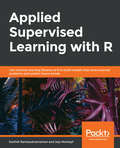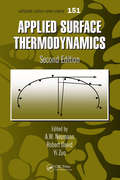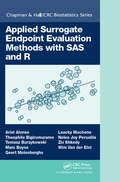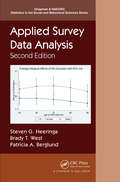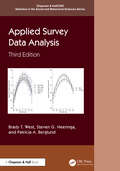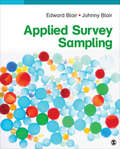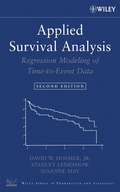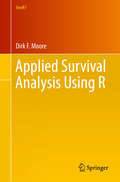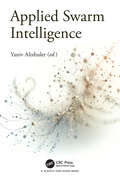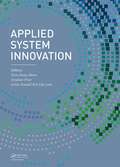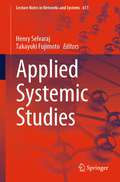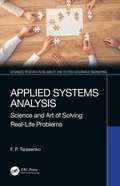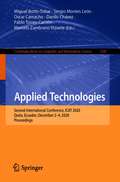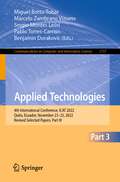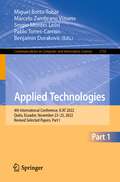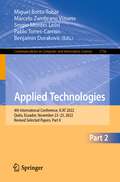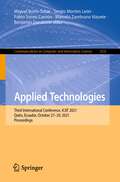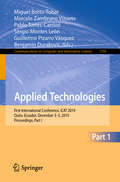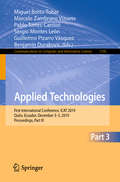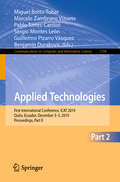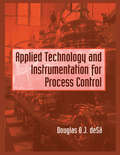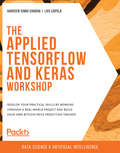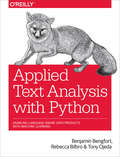- Table View
- List View
Applied Supervised Learning with R: Use machine learning libraries of R to build models that solve business problems and predict future trends
by Jojo Moolayil Karthik RamasubramanianExplore supervised machine learning with R by studying popular real-world uses cases such as object detection in driverless cars, customer churn, and default predictionKey FeaturesStudy supervised learning algorithms by using real-world datasets Fine tune optimal parameters with hyperparameter optimizationSelect the best algorithm using the model evaluation frameworkBook DescriptionR provides excellent visualization features that are essential for exploring data before using it in automated learning. Applied Supervised Learning with R helps you cover the complete process of employing R to develop applications using supervised machine learning algorithms for your business needs. The book starts by helping you develop your analytical thinking to create a problem statement using business inputs and domain research. You will then learn different evaluation metrics that compare various algorithms, and later progress to using these metrics to select the best algorithm for your problem. After finalizing the algorithm you want to use, you will study the hyperparameter optimization technique to fine-tune your set of optimal parameters. To prevent you from overfitting your model, a dedicated section will even demonstrate how you can add various regularization terms.By the end of this book, you will have the advanced skills you need for modeling a supervised machine learning algorithm that precisely fulfills your business needs.What you will learnDevelop analytical thinking to precisely identify a business problemWrangle data with dplyr, tidyr, and reshape2Visualize data with ggplot2Validate your supervised machine learning model using k-fold Optimize hyperparameters with grid and random search, and Bayesian optimizationDeploy your model on Amazon Web Services (AWS) Lambda with plumberImprove your model’s performance with feature selection and dimensionality reductionWho this book is forThis book is specially designed for novice and intermediate-level data analysts, data scientists, and data engineers who want to explore different methods of supervised machine learning and its various use cases. Some background in statistics, probability, calculus, linear algebra, and programming will help you thoroughly understand and follow the content of this book.
Applied Surface Thermodynamics (Surfactant Science)
by A. Wilhelm Neumann Robert David Yi ZuoSurface thermodynamics forms the foundation of any meaningful study of capillarity and wetting phenomena. The second edition of Applied Surface Thermodynamics offers a comprehensive state-of-the-art treatment of this critical topic. It provides students and researchers with fundamental knowledge and practical guidelines in solving real-world proble
Applied Surgical Physiology Vivas
by Mazyar Kanani Martin ElliottAn understanding of basic sciences is the cornerstone of medical and surgical training, and viva examinations in particular remain a source of anxiety for many candidates. Applied Surgery Physiology Vivas follows the same format as the hugely popular General Pathology Vivas and Surgical Critical Care Vivas. It gives candidates a means of practising some of the most common questions that they will be asked in their viva examinations, with detailed model answers and diagrams to highlight key points where necessary. Pocket-sized for portability, and packed with useful information in an easy-to-use A-Z format, this book will help the reader to broaden their knowledge base and, by practising the vivas, gain confidence in their examination technique.
Applied Surrogate Endpoint Evaluation Methods with SAS and R (Chapman & Hall/CRC Biostatistics Series)
by Ariel Alonso Theophile Bigirumurame Tomasz Burzykowski Marc Buyse Geert Molenberghs Leacky Muchene Nolen Joy Perualila Ziv Shkedy Wim Van der ElstAn important factor that affects the duration, complexity and cost of a clinical trial is the endpoint used to study the treatment’s efficacy. When a true endpoint is difficult to use because of such factors as long follow-up times or prohibitive cost, it is sometimes possible to use a surrogate endpoint that can be measured in a more convenient or cost-effective way. This book focuses on the use of surrogate endpoint evaluation methods in practice, using SAS and R.
Applied Survey Data Analysis (Chapman & Hall/CRC Statistics in the Social and Behavioral Sciences)
by Brady T. West Patricia A. Berglund Steven G. HeeringaHighly recommended by the Journal of Official Statistics, The American Statistician, and other journals, Applied Survey Data Analysis, Second Edition provides an up-to-date overview of state-of-the-art approaches to the analysis of complex sample survey data. Building on the wealth of material on practical approaches to descriptive analysis and regression modeling from the first edition, this second edition expands the topics covered and presents more step-by-step examples of modern approaches to the analysis of survey data using the newest statistical software. Designed for readers working in a wide array of disciplines who use survey data in their work, this book continues to provide a useful framework for integrating more in-depth studies of the theory and methods of survey data analysis. An example-driven guide to the applied statistical analysis and interpretation of survey data, the second edition contains many new examples and practical exercises based on recent versions of real-world survey data sets. Although the authors continue to use Stata for most examples in the text, they also continue to offer SAS, SPSS, SUDAAN, R, WesVar, IVEware, and Mplus software code for replicating the examples on the book’s updated website.
Applied Survey Data Analysis (Chapman & Hall/CRC Statistics in the Social and Behavioral Sciences)
by Brady T. West Steve G. Heeringa Patricia A. BerglundHighly recommended by the Journal of Official Statistics, The American Statistician, and other top statistical journals, Applied Survey Data Analysis, Third Edition provides an up-to-date overview of state-of-the-art approaches to the analysis of complex sample survey data. Building on the wealth of material on practical approaches to descriptive analysis and regression modeling from the first and second editions, this third edition further expands the topics covered and presents more step-by-step examples of modern approaches to the analysis of survey data using the newest statistical software procedures.New to the Third Edition: Applied Bayesian methods for the analysis of complex sample survey data using available software implementing these methods State-of-the-art methods and software for the analysis of survey data collected from non-probability samples Software for modern applications of machine learning techniques to complex sample survey data A completely revamped website providing code for replicating all the analyses illustrated in the book using Stata, SAS, SPSS, R, Mplus, SUDAAN, WesVar, and IVEware New end-of-chapter exercises, allowing for practice implementing the methods, including Bayesian analysis exercises Updated summaries of the newest literature on the analysis of survey data collected from complex samples An updated review of software packages currently available for the analysis of complex sample survey data Designed for readers working in a wide array of disciplines who conduct secondary analyses of survey data as part of their applied work, this book continues to provide a practical and accessible guide to the analysis of survey data. Continuing to use an example-driven approach to clearly illustrate analysis methods and software, the third edition contains many new examples and practical exercises based on recent versions of real-world survey data sets. Although the authors continue to use Stata for most examples in the text, they also offer the newest code for replicating the examples in other popular software packages on the book’s revamped website.
Applied Survey Sampling
by Johnny Blair Edward BlairWritten for students and researchers who wish to understand the conceptual and practical aspects of sampling, this book is designed to be accessible without requiring advanced statistical training. It covers a wide range of topics, from the basics of sampling to special topics such as sampling rare populations, sampling organizational populations, and sampling visitors to a place. Using cases and examples to illustrate sampling principles and procedures, the book thoroughly covers the fundamentals of modern survey sampling, and addresses recent changes in the survey environment such as declining response rates, the rise of Internet surveys, the need to accommodate cell phones in telephone surveys, and emerging uses of social media and big data.
Applied Survey Sampling
by Johnny Blair Edward BlairWritten for students and researchers who wish to understand the conceptual and practical aspects of sampling, this book is designed to be accessible without requiring advanced statistical training. It covers a wide range of topics, from the basics of sampling to special topics such as sampling rare populations, sampling organizational populations, and sampling visitors to a place. Using cases and examples to illustrate sampling principles and procedures, the book thoroughly covers the fundamentals of modern survey sampling, and addresses recent changes in the survey environment such as declining response rates, the rise of Internet surveys, the need to accommodate cell phones in telephone surveys, and emerging uses of social media and big data.
Applied Survival Analysis
by Susanne May Stanley Lemeshow David W. Hosmer Jr.THE MOST PRACTICAL, UP-TO-DATE GUIDE TO MODELLING AND ANALYZING TIME-TO-EVENT DATA--NOW IN A VALUABLE NEW EDITIONSince publication of the first edition nearly a decade ago, analyses using time-to-event methods have increase considerably in all areas of scientific inquiry mainly as a result of model-building methods available in modern statistical software packages. However, there has been minimal coverage in the available literature to9 guide researchers, practitioners, and students who wish to apply these methods to health-related areas of study. Applied Survival Analysis, Second Edition provides a comprehensive and up-to-date introduction to regression modeling for time-to-event data in medical, epidemiological, biostatistical, and other health-related research.This book places a unique emphasis on the practical and contemporary applications of regression modeling rather than the mathematical theory. It offers a clear and accessible presentation of modern modeling techniques supplemented with real-world examples and case studies. Key topics covered include: variable selection, identification of the scale of continuous covariates, the role of interactions in the model, assessment of fit and model assumptions, regression diagnostics, recurrent event models, frailty models, additive models, competing risk models, and missing data.Features of the Second Edition include:Expanded coverage of interactions and the covariate-adjusted survival functionsThe use of the Worchester Heart Attack Study as the main modeling data set for illustrating discussed concepts and techniquesNew discussion of variable selection with multivariable fractional polynomialsFurther exploration of time-varying covariates, complex with examplesAdditional treatment of the exponential, Weibull, and log-logistic parametric regression modelsIncreased emphasis on interpreting and using results as well as utilizing multiple imputation methods to analyze data with missing valuesNew examples and exercises at the end of each chapterAnalyses throughout the text are performed using Stata® Version 9, and an accompanying FTP site contains the data sets used in the book. Applied Survival Analysis, Second Edition is an ideal book for graduate-level courses in biostatistics, statistics, and epidemiologic methods. It also serves as a valuable reference for practitioners and researchers in any health-related field or for professionals in insurance and government.
Applied Survival Analysis Using R (Use R!)
by Dirk F. MooreApplied Survival Analysis Using R covers the main principles of survival analysis, gives examples of how it is applied, and teaches how to put those principles to use to analyze data using R as a vehicle. Survival data, where the primary outcome is time to a specific event, arise in many areas of biomedical research, including clinical trials, epidemiological studies, and studies of animals. Many survival methods are extensions of techniques used in linear regression and categorical data, while other aspects of this field are unique to survival data. This text employs numerous actual examples to illustrate survival curve estimation, comparison of survivals of different groups, proper accounting for censoring and truncation, model variable selection, and residual analysis. Because explaining survival analysis requires more advanced mathematics than many other statistical topics, this book is organized with basic concepts and most frequently used procedures covered in earlier chapters, with more advanced topics near the end and in the appendices. A background in basic linear regression and categorical data analysis, as well as a basic knowledge of calculus and the R system, will help the reader to fully appreciate the information presented. Examples are simple and straightforward while still illustrating key points, shedding light on the application of survival analysis in a way that is useful for graduate students, researchers, and practitioners in biostatistics.
Applied Swarm Intelligence
by Yaniv AltshulerThis book provides a comprehensive analysis of the tools and techniques used today for designing and modeling of efficient and robust swarm-intelligence based systems: highly (or fully) decentralized, semi-autonomous, highly-scalable infrastructures in various real-life scenarios. Among others, the book reviews the use of the swarm intelligence paradigm in financial investment, blockchain protocols design, shared transportation systems, communication networks, bioinformatics, and military applications. Theoretical and practical limitations of such systems, as well as trade-offs between the various economic and operational parameters of the systems, are discussed. The book is intended for researchers and engineers in the fields of swarm systems, economics, agriculture, nutrition, and operation research.
Applied System Innovation: Proceedings of the 2015 International Conference on Applied System Innovation (ICASI 2015), May 22-27, 2015, Osaka, Japan
by Teen-Hang Meen Stephen Prior Artde Donald LamThe 2015 International Conference on Applied System Innovation (ICASI 2015) was held May 22-27, 2015 in Osaka, Japan and provided a unified communication platform for researchers active in a wide range of research fields. Professionals from industry, academia and government were encouraged to discourse on research and development, professional practice, business and management in the information, innovation, communication and engineering fields. This conference enabled interdisciplinary collaboration between science and engineering technologists in the academic and industry fields as well as networking internationally. The conference received 1063 submitted papers, whereby 421 papers were selected by the committees to be presented at the ICASI 2015 conference. These papers were divided into 13 Regular Sessions and 13 Invited Sessions, and presented in several parallel sessions. The ICASI 2015 committees selected 226 excellent papers for publication in this proceedings volume, covering topics ranging from information technology, innovation design, communication science and engineering, industrial design, creative design, applied mathematics, computer science, design theory and cultural and creative research to electrical and electronic engineering, mechanical and automation engineering, green technology and architecture engineering and material science, among others.
Applied Systemic Studies (Lecture Notes in Networks and Systems #611)
by Henry Selvaraj Takayuki FujimotoThis book is a collection of a wide range of research papers that combine both the humanities and sciences in applied informatics. In particular, it is intended for readers interested in the fields of artificial intelligence, data science, virtual reality, and intelligent systems.Technologies and findings in artificial intelligence, data science, virtual reality, and intelligent systems are being used in all academic disciplines today. This book is a compilation of specific and advanced research findings from a wide range of research fields where they are being applied today. The papers included are based on those presented in August 2022 at the International Conference on Systems Engineering (ICSEng-Tokyo), a prestigious academic conference that has been held annually since 1974. The papers have been rigorously reviewed and selected by multiple peer reviewers.
Applied Systems Analysis: Science and Art of Solving Real-Life Problems (Advanced Research in Reliability and System Assurance Engineering)
by F. P. TarasenkoApplied Systems Analysis: Science and Art of Solving Real-Life Problems Subject Guide: Engineering – Industrial and Manufacturing Any activity is aimed at solving certain problems, which means transferring a system from an existing unsatisfactory problematic state to a desired state. The success or failure of the system depends on how its natural properties were implemented during the planning of improvement and intervention state. This book covers the theory and experience of successfully solving problems in a practical and general way. This book includes a general survey of modern systems analysis; offers several original results; presents the latest methodological and technological results of the theory of systems; introduces achievements; and discusses the transition from the ideology of the machine age to the ideology of the systems age. This book will be of interest to both professionals and academicians.
Applied Technologies: Second International Conference, ICAT 2020, Quito, Ecuador, December 2–4, 2020, Proceedings (Communications in Computer and Information Science #1388)
by Miguel Botto-Tobar Sergio Montes León Oscar Camacho Danilo Chávez Pablo Torres-Carrión Marcelo Zambrano VizueteThis volume constitutes the refereed proceedings of the Second International Conference on Applied Technologies, ICAT 2020, held in Quito, Ecuador, in December 2020. Due to the COVID-19 pandemic the conference was held online. The 53 papers were carefully reviewed and selected from 145 submissions. The papers are organized according to the following topics: communication; computing; e-government and e-participation; e-learning; electronics; intelligent systems; machine vision; security; technology trends.
Applied Technologies: Third International Conference, Icat 2021, Quito, Ecuador, October 27-29, 2021, Proceedings (Communications In Computer And Information Science Series #1535)
by Miguel Botto-Tobar Marcelo Zambrano Vizuete Sergio Montes León Pablo Torres-Carrión Benjamin Durakovic<p>This volume constitutes the refereed proceedings of the Third International Conference on Applied Technologies, ICAT 2021, held in Quito, Ecuador, in October 2021.<p> <p>The 40 papers were carefully reviewed and selected from 201 submissions. The papers are organized according to the following topics: communication; computing; e-government and e-participation; e-learning; electronics; general track; intelligent systems; machine vision; security; technology trends.<p>
Applied Technologies: Third International Conference, Icat 2021, Quito, Ecuador, October 27-29, 2021, Proceedings (Communications In Computer And Information Science Series #1535)
by Miguel Botto-Tobar Marcelo Zambrano Vizuete Sergio Montes León Pablo Torres-Carrión Benjamin Durakovic<p>This volume constitutes the refereed proceedings of the Third International Conference on Applied Technologies, ICAT 2021, held in Quito, Ecuador, in October 2021.<p> <p>The 40 papers were carefully reviewed and selected from 201 submissions. The papers are organized according to the following topics: communication; computing; e-government and e-participation; e-learning; electronics; general track; intelligent systems; machine vision; security; technology trends.<p>
Applied Technologies: 4th International Conference, ICAT 2022, Quito, Ecuador, November 23–25, 2022, Revised Selected Papers, Part II (Communications in Computer and Information Science #1756)
by Miguel Botto-Tobar Marcelo Zambrano Vizuete Sergio Montes León Pablo Torres-Carrión Benjamin DurakovicThis three-volume set CCIS 1755-1757 constitutes the refereed proceedings of the 4th International Conference on Applied Technologies, ICAT 2022, held in Quito, Ecuador, in November 2022. The 112 full papers included in this book were carefully reviewed and selected from 415 submissions. They were organized in topical sections as follows: human computing and information science, IT financial and business management.
Applied Technologies: Third International Conference, ICAT 2021, Quito, Ecuador, October 27–29, 2021, Proceedings (Communications in Computer and Information Science #1535)
by Miguel Botto-Tobar Marcelo Zambrano Vizuete Pablo Torres-Carrión Sergio Montes León Benjamin DurakovicThis volume constitutes the refereed proceedings of the Third International Conference on Applied Technologies, ICAT 2021, held in Quito, Ecuador, in October 2021. The 40 papers were carefully reviewed and selected from 201 submissions. The papers are organized according to the following topics: communication; computing; e-government and e-participation; e-learning; electronics; general track; intelligent systems; machine vision; security; technology trends.
Applied Technologies: First International Conference, ICAT 2019, Quito, Ecuador, December 3–5, 2019, Proceedings, Part I (Communications in Computer and Information Science #1193)
by Miguel Botto-Tobar Marcelo Zambrano Vizuete Pablo Torres-Carrión Sergio Montes León Guillermo Pizarro Vásquez Benjamin DurakovicThis first volume of the three-volume set (CCIS 1193, CCIS 1194, and CCIS 1195) constitutes the refereed proceedings of the First International Conference on Applied Technologies, ICAT 2019, held in Quito, Ecuador, in December 2019. The 124 full papers were carefully reviewed and selected from 328 submissions. The papers are organized according to the following topics: technology trends; computing; intelligent systems; machine vision; security; communication; electronics; e-learning; e-government; e-participation.
Applied Technologies: First International Conference, ICAT 2019, Quito, Ecuador, December 3–5, 2019, Proceedings, Part III (Communications in Computer and Information Science #1195)
by Miguel Botto-Tobar Marcelo Zambrano Vizuete Pablo Torres-Carrión Sergio Montes León Guillermo Pizarro Vásquez Benjamin DurakovicThis thirs volume of the three-volume set (CCIS 1193, 1194, 1195) constitutes the refereed proceedings of the First International Conference on Applied Technologies, ICAT 2019, held in Quito, Ecuador, in December 2019. The 124 full papers were carefully reviewed and selected from 328 submissions. The papers are organized according to the following topics: technology trends; computing; intelligent systems; machine vision; security; communication; electronics; e-learning; e-government; e-participation.
Applied Technologies: First International Conference, ICAT 2019, Quito, Ecuador, December 3–5, 2019, Proceedings, Part II (Communications in Computer and Information Science #1194)
by Miguel Botto-Tobar Marcelo Zambrano Vizuete Pablo Torres-Carrión Sergio Montes León Guillermo Pizarro Vásquez Benjamin DurakovicThis second volume of the three-volume set (CCIS 1193, CCIS 1194, and CCIS 1195) constitutes the refereed proceedings of the First International Conference on Applied Technologies, ICAT 2019, held in Quito, Ecuador, in December 2019. The 124 full papers were carefully reviewed and selected from 328 submissions. The papers are organized according to the following topics: technology trends; computing; intelligent systems; machine vision; security; communication; electronics; e-learning; e-government; e-participation.
Applied Technology and Instrumentation for Process Control
by Douglas O. de SaApplied Technology and Instrumentation for Process Control presents the complex technologies of different manufacturing processes and the control instrumentation used. The large variety of processes prohibits covering more than a few. Carefully selected and diverse, but representative, examples show how fundamentally basic simpler elements or techn
The Applied TensorFlow and Keras Workshop: Develop your practical skills by working through a real-world project and build your own Bitcoin price prediction tracker
by Luis Capelo Harveen Singh ChadhaCut through the noise and get real results with this workshop for beginners. Use a project-based approach to exploring machine learning with TensorFlow and Keras. Key Features Understand the nuances of setting up a deep learning programming environment Gain insights into the common components of a neural network and its essential operations Get to grips with deploying a machine learning model as an interactive web application with Flask Book Description Machine learning gives computers the ability to learn like humans. It is becoming increasingly transformational to businesses in many forms, and a key skill to learn to prepare for the future digital economy. As a beginner, you'll unlock a world of opportunities by learning the techniques you need to contribute to the domains of machine learning, deep learning, and modern data analysis using the latest cutting-edge tools. The Applied TensorFlow and Keras Workshop begins by showing you how neural networks work. After you've understood the basics, you will train a few networks by altering their hyperparameters. To build on your skills, you'll learn how to select the most appropriate model to solve the problem in hand. While tackling advanced concepts, you'll discover how to assemble a deep learning system by bringing together all the essential elements necessary for building a basic deep learning system - data, model, and prediction. Finally, you'll explore ways to evaluate the performance of your model, and improve it using techniques such as model evaluation and hyperparameter optimization. By the end of this book, you'll have learned how to build a Bitcoin app that predicts future prices, and be able to build your own models for other projects. What you will learn Familiarize yourself with the components of a neural network Understand the different types of problems that can be solved using neural networks Explore different ways to select the right architecture for your model Make predictions with a trained model using TensorBoard Discover the components of Keras and ways to leverage its features in your model Explore how you can deal with new data by learning ways to retrain your model Who this book is for If you are a data scientist or a machine learning and deep learning enthusiast, who is looking to design, train, and deploy TensorFlow and Keras models into real-world applications, then this workshop is for you. Knowledge of computer science and machine learning concepts and experience in analyzing data will help you to understand the topics explained in this book with ease.
Applied Text Analysis with Python: Enabling Language-Aware Data Products with Machine Learning
by Benjamin Bengfort Rebecca Bilbro Tony OjedaFrom news and speeches to informal chatter on social media, natural language is one of the richest and most underutilized sources of data. Not only does it come in a constant stream, always changing and adapting in context; it also contains information that is not conveyed by traditional data sources. The key to unlocking natural language is through the creative application of text analytics. This practical book presents a data scientist’s approach to building language-aware products with applied machine learning.You’ll learn robust, repeatable, and scalable techniques for text analysis with Python, including contextual and linguistic feature engineering, vectorization, classification, topic modeling, entity resolution, graph analysis, and visual steering. By the end of the book, you’ll be equipped with practical methods to solve any number of complex real-world problems.Preprocess and vectorize text into high-dimensional feature representationsPerform document classification and topic modelingSteer the model selection process with visual diagnosticsExtract key phrases, named entities, and graph structures to reason about data in textBuild a dialog framework to enable chatbots and language-driven interactionUse Spark to scale processing power and neural networks to scale model complexity
